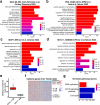In vivo CRISPR screens identify a dual function of MEN1 in regulating tumor-microenvironment interactions
- PMID: 39227744
- PMCID: PMC11387198
- DOI: 10.1038/s41588-024-01874-9
In vivo CRISPR screens identify a dual function of MEN1 in regulating tumor-microenvironment interactions
Abstract
Functional genomic screens in two-dimensional cell culture models are limited in identifying therapeutic targets that influence the tumor microenvironment. By comparing targeted CRISPR-Cas9 screens in a two-dimensional culture with xenografts derived from the same cell line, we identified MEN1 as the top hit that confers differential dropout effects in vitro and in vivo. MEN1 knockout in multiple solid cancer types does not impact cell proliferation in vitro but significantly promotes or inhibits tumor growth in immunodeficient or immunocompetent mice, respectively. Mechanistically, MEN1 knockout redistributes MLL1 chromatin occupancy, increasing H3K4me3 at repetitive genomic regions, activating double-stranded RNA expression and increasing neutrophil and CD8+ T cell infiltration in immunodeficient and immunocompetent mice, respectively. Pharmacological inhibition of the menin-MLL interaction reduces tumor growth in a CD8+ T cell-dependent manner. These findings reveal tumor microenvironment-dependent oncogenic and tumor-suppressive functions of MEN1 and provide a rationale for targeting MEN1 in solid cancers.
© 2024. The Author(s).
Conflict of interest statement
F.B. is Vice President of Translational Research of Kura Oncology, Inc. The other authors declare no competing interests.
Figures
















References
-
- Mantovani, A., Allavena, P., Sica, A. & Balkwill, F. Cancer-related inflammation. Nature454, 436–444 (2008). - PubMed
-
- Hanahan, D. & Weinberg, R. A. Hallmarks of cancer: the next generation. Cell144, 646–674 (2011). - PubMed
-
- Balkwill, F. R., Capasso, M. & Hagemann, T. The tumor microenvironment at a glance. J. Cell Sci.125, 5591–5596 (2012). - PubMed
MeSH terms
Substances
Grants and funding
- 886012001223/Princess Margaret Cancer Foundation (PMCF)
- 142246, 152863,152864,159567,438793/Gouvernement du Canada | Canadian Institutes of Health Research (Instituts de Recherche en Santé du Canada)
- FDN-148395/Gouvernement du Canada | Canadian Institutes of Health Research (Instituts de Recherche en Santé du Canada)
- 1090, 1124/Terry Fox Research Institute (Institut de Recherche Terry Fox)
- 31801111/National Natural Science Foundation of China (National Science Foundation of China)
LinkOut - more resources
Full Text Sources
Molecular Biology Databases
Research Materials

